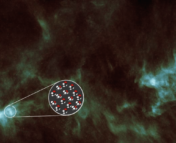Title: Salt, Hot Water, and Silicon Compounds Tracing Massive Twin Disks
Authors: Kei E. I. Tanaka, Yichen Zhang, Tomoya Hirota, Nami Sakai, Kazuhito Motogi, Kengo Tomida, Jonathan C. Tan, Viviana Rosero, Aya E. Higuchi, Satoshi Ohashi, Mengyao Liu, Koichiro Sugiyama
First Author’s Institution: National Astronomical Observatory of Japan, Mitaka, Tokyo, Japan
Status: Submitted to The Astrophysical Journal Letters [open access on arXiv]
How Do Massive Stars Form?
Massive stars have an outsized impact on their local environments and throughout entire galaxies, as they are important sources of UV radiation, turbulent energy, and heavy elements. While the formation of their low-mass counterparts is largely understood, the process of forming high-mass stars is still unclear. It is unknown whether massive protostars accrete through disks – a scaled-up version of low-mass star formation – or form through an otherwise distinct mechanism.
While recent theoretical work and simulations support this disk accretion model, detecting the presence of such disks is not free from observationally difficulties. To do so, observers seek to identify the signatures of rotating gas within these disks by using molecular emission lines at millimeter wavelengths. But high spatial resolutions are required to correctly disentangle emission from molecules in the inner disk versus those associated with surrounding gas structures, such as protostellar envelopes and outflows. The advent of interferometers, such as the Atacama Large Millimeter/Submillimeter Array (ALMA), provided the necessary angular resolutions and have led to the detections of an increasing number of disk-like structures around massive protostars. But, despite this, there is no consensus as to which molecular lines uniquely trace these massive circumstellar disks. Moreover, few studies have been conducted at sufficiently small spatial scales to directly probe the structure of these disks.
In today’s astrobite, we take a look at new high spatial resolution observations of massive protostellar object IRAS 16547-4247, which reveal the presence of two rotating massive disks and identify a potentially-universal “hot-disk” chemistry found in the innermost disks around massive protostars.
Massive Twin Disks in IRAS 16547-4247
Today’s authors used ALMA to observe the massive protostellar system IRAS 16547-4247, which is located over 9,000 lightyears from Earth. Previous radio observations revealed the presence of jets and indicated that accretion is currently ongoing in the vicinity of the protostar. IRAS 16547 is also known to be a binary system, comprised of two compact dusty objects with a separation of 300 AU, surrounded by a larger, rotating circumbinary disk. By observing IRAS 16547 at a resolution of only a few hundreds of AU, today’s authors are able to investigate the gas dynamics of both massive protostellar disks in detail.
Figure 1 shows the continuum images of IRAS 16547 taken with ALMA. Emission from dust dominates the 1.3 mm continuum, highlighting the circumbinary disk and outflow cavities, while the 3 mm continuum reveals the jet structures. Three individual protostars are seen at both wavelengths: IRAS 16547-Ea (source A) and IRAS 16547-Eb (source B), which form the proto-binary, and a weaker third source IRAS 16547-W. The proto-binary comprised of sources A and B is surrounded by a circumbinary disk, while outflow cavities are located to the north and south.

A wide variety of molecular lines are also detected in IRAS 16547. Figure 2 shows the integrated intensity maps of representative emission lines, which trace different components in the proto-binary system from the circumbinary disk to the individual circumstellar disks. For instance, lines from molecules such as methyl cyanide (CH3CN) and sulfur dioxide (SO2), which are often assumed to trace disks, are instead found toward the circumbinary disk and outflow cavity. On the other hand, emission from super-heated water (H2O), silicon compounds such as SiO and SiS, and sodium chloride (NaCl) trace the individual protostellar disks. Notably, this is only the second detection of NaCl in a protostellar system, after the Orion Source I disk.

Inner Disk Tracers: Hot Water and Salt
Figure 3 shows the velocity structure of selected lines that trace the rotation of the individual disks. In source B, the velocity gradients are close to parallel to disk A’s rotation, but in the opposite direction, suggesting that the circumstellar disk of source B is rotating in the opposite direction as disk A and the circumbinary disk.

As seen in both the overall integrated intensities in Figure 2 and the velocity structures in Figure 3, there are two classes of molecules that trace the innermost 100-AU scale of the massive binary system: vibrationally-excited “hot” lines, which is best illustrated by hot H2O; and refractory molecules, such as NaCl and silicon compounds SiO and SiS, which originate from the destruction of dust grains. A summary of the inferred physical structure of IRAS 16547 is shown in Figure 4.

Implications of “Hot-disk” Chemistry
These results suggest that hot water, silicon compounds, and salts may be common in hot massive protostellar sources and serve as valuable tracers of inner disk material. The presence of this “hot-disk” chemistry provides a promising path for future studies of massive star formation.
In addition, hot-disk chemistry has an important link to meteoritics in our solar system. The oldest materials contained in primitive meteorites are those associated with Ca-Al-rich inclusions (CAIs), which were either sublimated or molten at some point in our proto-solar disk. This means that the pre-solar nebula had to be heated to at least 1500 K, which is in apparent contrast with the low temperatures of a few hundred Kelvin typically associated with protoplanetary disks. Thus, it is still unclear how and where CAIs formed. Further observations of hot-disk chemistry may provide important constraints on gas-phase conditions of refractory molecules and provide insight into the formation of high-temperature meteoritic components.




